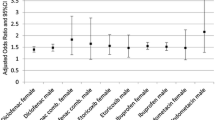Abstract
Background
Non-steroidal anti-inflammatory drugs (NSAIDs) are widely used in the elderly. NSAIDs may cause a series of adverse drug reactions, of which gastrointestinal, renovascular/cardiovascular and bleeding complications are of particular concern. Concomitant use of several other drugs may further increase the risk of these adverse effects.
Objective
To examine the extent of chronic use of NSAIDs and co-prescription of drugs which may seriously interact with NSAIDs in elderly subjects, by using data from the Norwegian Prescription Database.
Results
A total of 7.3% of all individuals (71,681/984,457) over 60 years of age filled at least one prescription for reimbursed NSAIDs during the 1-year study period (2006). Co-prescription of medications which may interact with NSAIDs was prevalent for drugs used for hypertension and/or heart failure (59.5%), antithrombotic drugs (35.1%), systemic glucocorticoids (12.9%) and SSRI antidepressants (8.3%). As many as 4.8 and 3.8% of NSAID users were co-prescribed warfarin or oral methotrexate respectively.
Conclusion
The frequent co-prescription of medications which may cause detrimental interactions in elderly chronic NSAID users adds to safety concerns regarding this widely prescribed class of drugs.

Similar content being viewed by others
References
Seager JM, Hawkey CJ (2001) Indigestion and non-steroidal antiinflammatory drugs. BMJ 323:1236–1239
Hawkey CJ, Langman MJS (2003) Non-steroidal antiinflammatory drugs: overall risks and management. Complementary roles for COX-2 inhibitors and proton pump inhibitors. Gut 52:600–608
Pope JE, Andersson JJ, Felson DT (1993) A meta-analysis of the effects of NSAIDs on blood pressure. Arch Intern Med 153:477–484
Johnson AG, Nguyen TV, Day RO (1994) Do nonsteroidal anti-inflammatory drugs affect blood pressure? A meta-analysis. Ann Intern Med 121:289–300
Garcia Rodriguez LA, Hernandez-Diaz S (2003) Nonsteroidal antiinflammatory drugs as a trigger of clinical heart failure. Epidemiology 14:240–246
Whelton A, Hamilton CW (1991) Non-steroidal anti-inflammatory drugs: effects on kidney function. J Clin Pharmacol 31:588–598
Patrono C, Patrignani P, Garcia Rodriguez LA (2001) Cyclooxygenase-selective inhibition of prostanoid formation: transducing biochemical selectivity into clinical read-outs. J Clin Invest 108:7–13
Baxter K (ed) (2008) Stockley’s drug interactions, 8th edn. Pharmaceutical Press, London
Furu K, Strøm H, Rønning M, Skurtveit S, Engedal A, Tverdal A (2005) The Norwegian Prescription Database (NorPD): new register for pharmacoepidemiological research covering a whole nation. Pharmacoepidemiol Drug Saf 14(Suppl 2):S48
WHO Collaborating Centre for Drug Statistics Methodology (2008) ATC classification index with DDDs 2009. WHO, Oslo
Fries JF (1991) NSAID gastropathy: the second most deadly rheumatic disease? Epidemiology and risk appraisal. Rheumatology 28(Suppl):6–10
Hudson N, Hawkey CJ (1993) Non-steroidal anti-inflammatory drug-associated upper gastointestinal ulceration and complications. Eur J Gastroenterol Hepatol 5:412–419
Weil J, Colin-Jones D, Langman M, Lawson D, Logan R, Murphy M, Rawlins M, Vessey M, Wainwright P (1995) Prophylactic aspirin and risk of peptic ulcer bleeding. BMJ 310:827–830
Sorensen HT, Mellomkjær L, Blot WJ, Nielsen GL, Steffensen FH, McLaughlin JK, Olsen JH (2000) Risk of upper gastrointestinal bleeding associated with use of low-dose aspirin. Am J Gastroenterol 95:2218–2224
Shorr RI, Ray WA, Daugherty JR, Griffin MR (1993) Concurrent use of nonsteroidal anti-inflammatory drugs and oral anticoagulants places elderly persons at high risk for hemorrhagic peptic ulcer disease. Arch Intern Med 153:1665–1670
Battistella M, Mamdami MM, Juurlink DN, Rabeneck L, Laupacis A (2005) Risk of upper gastrointestiunal hemorrhage in warfarin users treated with nonselective NSAIDs or COX-2-inhibitors. Arch Intern Med 165:189–192
Helin-Salmivaara A, Huttunen T, Gronroos JM, Klaukka T, Huupponen R (2007) Risk of serious upper gastrointestinal events with concurrent use of NSAIDs and SSRIs: a case-control study in the general population. Eur J Clin Pharmacol 63:403–408
Johnson AG, Simons LA, Simons J, Friedlander Y, McCallum J (1993) Nonsteroidal anti-inflammatory drugs and hypertension in the elderly: a community-based cross-sectional study. Br J Clin Pharmacol 35:455–459
Gurwitz JH, Avorn J, Bohn RL, Glynn RJ, Monane M, Mogun H (1994) Initiation of antihypertensive treatment during nonsteroidal anti-inflammatory drug therapy. JAMA 272:781–786
Heerdink ER, Leufkens HG, Herings RMC, Ottervanger JP, Stricker BH, Bakker A (1998) NSAIDs associated with increased risk of congestive heart failure in elderly patients taking diuretics. Arch Intern Med 158:1108–1112
Page J, Henry D (2000) Consumption of NSAIDs and the development of congestive heart failure in elderly patients: an unrecognized public health problem. Arch Intern Med 160:777–784
Merlo J, Broms K, Lindblad U, Björck-Linné A, Liedholm H, Östergren PO, Erhardt L, Råstam L, Melander A (2001) Association of outpatient utilisation of non-steroidal antiinflammatory drugs and hospitalised heart failure in the entire Swedish population. Eur J Clin Pharmacol 57:71–75
Feenstra J, Heerdink ER, Grobbe DE, Stricker BH (2002) Association of nonsteroidal anti-inflammatory drugs with first occurrence of heart failure and with relapsing heart failure: the Rotterdam study. Arch Intern Med 162:265–270
Mamdani M, Juurlink DN, Lee DS, Rochon PA, Kopp A, Naglie G, Austin PC, Laupacis A, Stukel TA (2004) Cyclo-oxygenase-2 inhibitors versus non-selective non-steroidal anti-inflammatory drugs and congestive heart failure outcomes in elderly patients: a population-based cohort study. Lancet 363:175–176
Hudson M, Richard H, Pilote L (2005) Differences in outcomes of patients with congestive heart failure prescribed celecoxib, rofecoxib, or non-steroidal anti-inflammatory drugs: population based study. BMJ 330:1370–1375
Bjordal JM, Ljunggren AE, Klovning A, Slørdal L (2004) Non-steroidal anti-inflammatory drugs, including cyclo-oxygenase-2 inhibitors, in osteoarthritic knee pain: meta-analysis of randomised placebo-controlled trials. BMJ 329:1317–1322
Author information
Authors and Affiliations
Corresponding author
Rights and permissions
About this article
Cite this article
Vandraas, K.F., Spigset, O., Mahic, M. et al. Non-steroidal anti-inflammatory drugs: use and co-treatment with potentially interacting medications in the elderly. Eur J Clin Pharmacol 66, 823–829 (2010). https://doi.org/10.1007/s00228-010-0825-2
Received:
Accepted:
Published:
Issue Date:
DOI: https://doi.org/10.1007/s00228-010-0825-2




